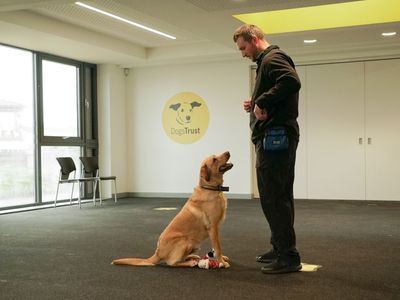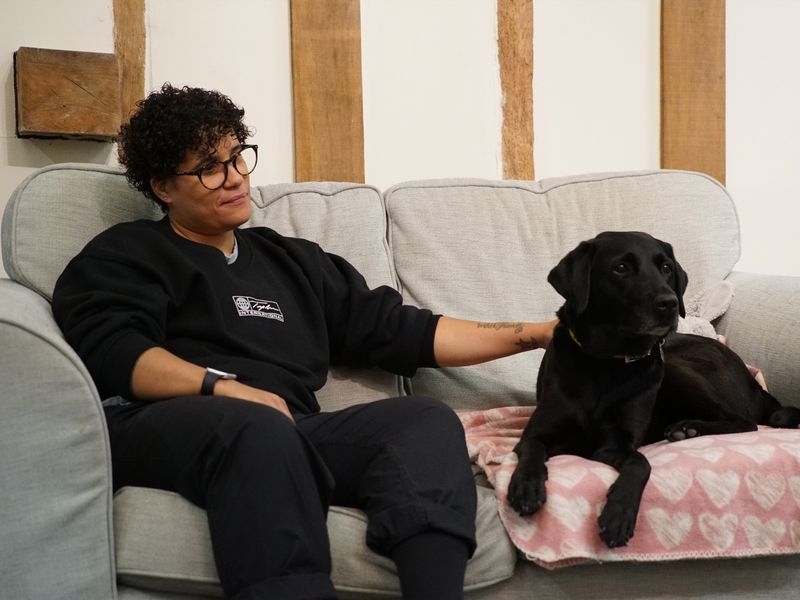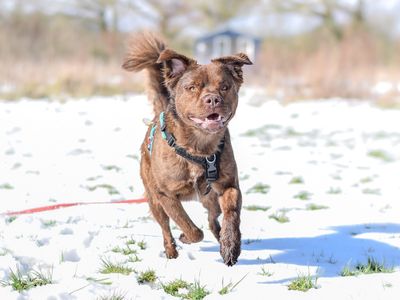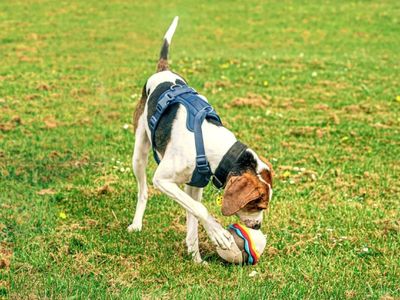
How to prepare your dog for visitors
Find out how to help to help your dog feel calm when visitors knock on your door and come into your home.

The sound of the doorbell or a knock on the door can make some dogs feel excited or nervous. So, before you start welcoming visitors, you should prepare your dog and teach them to feel calm.
Teach your dog not to react to a knock on the door
Feelings of excitement or anxiety can start the moment there is a knock on the door. So, how do you train your dog to stay calm when guests come over and they hear this noise? Firstly, you should get them used to the sounds in a positive way, then progress to an actual door.
Knock on a table
Quietly knock on a hard surface such as a table and see how your dog responds.
See how they respond
If your dog barks or rushes to the door, then make the knock quieter – the aim is for your dog to stay calm when they hear the noise
Increase volume
Gradually increase the volume and frequency – do this until your dog is ignoring reasonably loud knocks.
Introduce a doorbell sound
Repeat the process with the noise of a doorbell – you could try using a doorbell sound on your phone.
Move on to a door
Once you and your pooch have mastered these steps, you can move on to knocking on an actual door.
Grab a buddy for their help
Ask someone to go outside (while you stay with your dog), approach and knock on the front door once.
See how your dog responds
See how your dog responds to the knock at the door. If they remain calm, mark and reward them for being so good.
You could offer your pup an enjoyable activity such as a food-releasing toy or snuffle mat – this will encourage them to settle and remain …
Knock again
While your dog is enjoying their treat, your helper should knock again, very quietly to begin with. Then gradually increase the number and volume of knocks.
Repeat
Repeat this process with your doorbell.
The noise will eventually become meaningless to your dog, as it isn’t resulting in anyone coming in.
Top tip: Put a sign on your front door asking people not to knock or ring the doorbell while you are doing the training. Otherwise, this may get confusing for your pooch and could slow down their progress.
At first, you want them to learn that a knock doesn’t result in anything else happening. This is why you don’t want people turning up unexpectedly and disrupting the training.
Watch our video to discover how to train your dog for visitors.
Encourage your dog to go to their bed when there is a knock at the door
Your pup is used to the sound of knocking or the doorbell ringing. Now you can teach them to go to their bed so they can settle there while visitors enter your home. To do this, make sure they have a comfy, cosy bed of their own – ideally in a room that visitors won't go in.
Encourage your dog to go on their bed
Start by throwing some treats on your dog's bed and encouraging them to go to it.
Once your dog has the hang of this, you can introduce a cue.
Introduce a cue word
Say the word “bed” and point to it, then reward your dog once they get there. Repeat this, and gradually increase the distance between you and your dog’s bed.
Increase the time
Slowly increase the amount of time your dog stays on their bed by rewarding them there. Then, take a step back and reward them there again.
Remember that training should always be positive. We want our dogs to see their bed as a really great and safe place to …
Add a door knock or bell ring
Once your dog is reliably going to their bed on your cue, you can introduce the doorbell or knock.
Ask someone to knock on your front door or ring the doorbell. Then give your cue and once your dog is in their bed, reward them with a treat.
Dedicate time to training
Repeat this training session for around 10 minutes.
Over time, your dog should start running to their bed by themselves when they hear the knock or doorbell.
You’ve taught your pooch to go to their bed and wait when there is a knock at the door or the doorbell rings. Now you can start to give them a long-lasting treat and close the door for a short period of time. Repeat this several times. Then, you should be able to bring the guests into your home while your pooch is devouring their treat in bed.
Top tip: If you want to ask your dog to come off the bed, you can say “OK” or “off”, so you keep things very clear.
Introduce your dog to real guests
Your dog now knows that a knock on the door means they go to their bed. So, when your visitor arrives, as above, leave your pooch there with a long-lasting treat and close the door.
You can now invite your guests in and let them settle down. Your dog should be calm so, if your visitors are happy to meet them, you can bring your pooch in.
They know how to respond to the arrival of guests. This should mean they are relaxed after real visitors knock or ring the doorbell, for the first time.
Top tip: Keep a long-lasting treat close by. That way, you can follow the same routine with visitors that you aren’t expecting, as well as with the ones that you are.
Stop your dog jumping up at visitors
Is your dog jumping up at your visitors? Then you need to ensure you train them to greet guests calmly and quietly.

Avoid your dog barking at visitors
Perhaps your dog barks at visitors? This could be due to excitement, but could also be a sign that they feel anxious about their arrival.
Prevent an over-excited puppy from mouthing visitors
If you have an over-excited puppy mouthing your visitors, then you need to teach them what they can and cannot chew. You can do this by providing your puppy with a range of suitable toys and chews to play with.
Extra behavioural support
Remember, help is there for you if you need it. If you feel as though your dog is struggling to have visitors in the home, or you're struggling to cope with their behaviour, an accredited behaviourist will be able to offer you practical support and guidance.
Or speak to our team of dog behaviour specialists on our Behaviour Support Line for free expert advice.
Related articles








